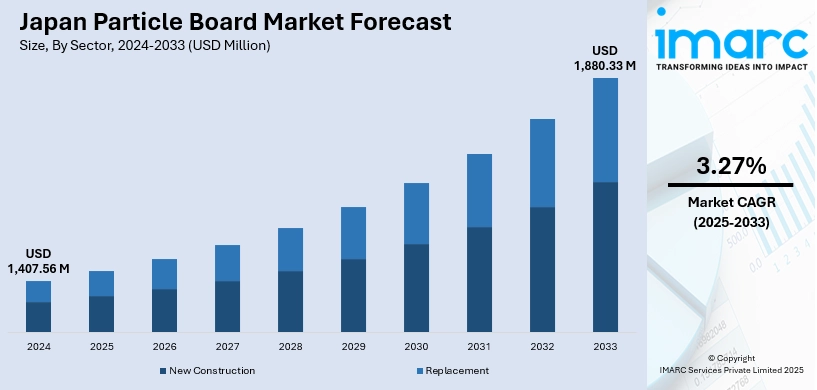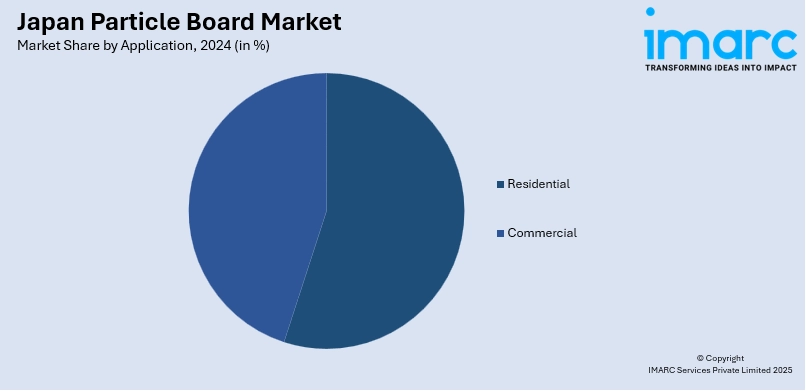
Japan Particle Board Market Size, Share, Trends and Forecast by Application, Sector, and Region, 2025-2033
Japan Particle Board Market Overview:
The Japan particle board market size reached USD 1,407.56 Million in 2024. Looking forward, IMARC Group expects the market to reach USD 1,880.33 Million by 2033, exhibiting a growth rate (CAGR) of 3.27% during 2025-2033. The market is driven by rising demand in furniture manufacturing, increased adoption in modular interiors, and a push toward sustainable construction materials. Technological advancements and wood waste utilization also play key roles in positively influencing the Japan particle board market share in recent years.
|
Report Attribute
|
Key Statistics
|
|---|---|
|
Base Year
|
2024
|
|
Forecast Years
|
2025-2033
|
|
Historical Years
|
2019-2024
|
| Market Size in 2024 | USD 1,407.56 Million |
| Market Forecast in 2033 | USD 1,880.33 Million |
| Market Growth Rate 2025-2033 | 3.27% |
Japan Particle Board Market Trends:
Expansion in Earthquake-Resilient Building Materials
Japan’s frequent seismic activity has driven innovation in construction materials, including particle boards designed for enhanced structural resilience. For instance, in January 2024, a strong 7.5–7.6 magnitude earthquake hit Japan's Noto Peninsula, causing tsunamis up to 47 inches high, flooding 296 acres, and triggering nearly 1,000 landslides. Japan’s significant seismic risk arises from its location along the Pacific Ring of Fire, where four tectonic plates converge, leading to about 2,000 perceptible earthquakes annually. In response, manufacturers are advancing particle boards by enhancing bonding agents and incorporating layered reinforcements to improve shock absorption and minimize cracking under seismic stress. This development aligns with Japan’s stringent building regulations and consumer demand for safer housing solutions. Furthermore, builders are using particle board in internal wall claddings, flooring, and ceiling substrates that offer both strength and aesthetic versatility. Partnerships between construction companies and board producers are promoting new standards in safety-compliant material sourcing. As the need for earthquake-resilient materials rises, this application niche is poised to significantly contribute to Japan particle board market growth, positioning the material as a reliable, lightweight, and cost-effective option in residential and commercial projects.

To get more information on this market, Request Sample
Rising Influence of Circular Economy Initiatives
The influence of Japan’s environmental policies and circular economy initiatives has become a key driver in particle board production. Manufacturers are increasingly turning to recycled wood, agricultural residues, and sawmill by-products as alternative raw materials, reducing dependency on virgin timber. This shift supports the government’s low-carbon strategy while cutting material costs. Additionally, life cycle assessment (LCA) tools are being widely adopted to measure the environmental footprint of particle board products, guiding producers toward greener practices. Certifications such as FSC and Eco Mark have gained importance, making eco-compliant boards more appealing to both local builders and export markets. These sustainability-driven measures are not only reshaping manufacturing processes but also fueling Japan particle board market growth, as eco-conscious consumers and developers seek responsible sourcing and production transparency. For instance, Tokyo Board Industries collects waste wood from construction, demolition sites, warehouses, and ports, recycling it into particle board to reduce CO2 emissions and mitigate global warming. Their logistics combine product delivery with waste collection, cutting emissions. The recycled particle board is reused in housing materials, creating a sustainable loop by reprocessing end-of-life boards instead of incineration. Recent data shows acceptance of 117,266 tons of waste wood and shipment of 88,115 tons of particle board, highlighting their circular economy impact.
Japan Particle Board Market Segmentation:
IMARC Group provides an analysis of the key trends in each segment of the market, along with forecasts at the country/region level for 2025-2033. Our report has categorized the market based on application and sector.
Application Insights:

- Residential
- Commercial
The report has provided a detailed breakup and analysis of the market based on the application. This includes residential and commercial.
Sector Insights:
- New Construction
- Replacement
A detailed breakup and analysis of the market based on the sector have also been provided in the report. This includes new construction and replacement.
Regional Insights:
- Kanto Region
- Kansai/Kinki Region
- Central/Chubu Region
- Kyushu-Okinawa Region
- Tohoku Region
- Chugoku Region
- Hokkaido Region
- Shikoku Region
The report has also provided a comprehensive analysis of all the major regional markets, which include Kanto Region, Kansai/Kinki Region, Central/Chubu Region, Kyushu-Okinawa Region, Tohoku Region, Chugoku Region, Hokkaido Region, and Shikoku Region.
Competitive Landscape:
The market research report has also provided a comprehensive analysis of the competitive landscape. Competitive analysis such as market structure, key player positioning, top winning strategies, competitive dashboard, and company evaluation quadrant has been covered in the report. Also, detailed profiles of all major companies have been provided.
Japan Particle Board Market News:
- In July 2024, Japan’s Daiken Corp. and Itochu Corp. acquired Panolam’s particleboard mill in Huntsville, Ontario. The move enables the companies to install a line for producing a new panel type. This marks Daiken and Itochu’s strategic expansion into advanced wood-based panels.
Japan Particle Board Market Report Coverage:
| Report Features | Details |
|---|---|
| Base Year of the Analysis | 2024 |
| Historical Period | 2019-2024 |
| Forecast Period | 2025-2033 |
| Units | Million USD |
| Scope of the Report |
Exploration of Historical Trends and Market Outlook, Industry Catalysts and Challenges, Segment-Wise Historical and Future Market Assessment:
|
| Applications Covered | Residential, Commercial |
| Sectors Covered | New Construction, Replacement |
| Regions Covered | Kanto Region, Kansai/Kinki Region, Central/Chubu Region, Kyushu-Okinawa Region, Tohoku Region, Chugoku Region, Hokkaido Region, Shikoku Region |
| Customization Scope | 10% Free Customization |
| Post-Sale Analyst Support | 10-12 Weeks |
| Delivery Format | PDF and Excel through Email (We can also provide the editable version of the report in PPT/Word format on special request) |
Key Questions Answered in This Report:
- How has the Japan particle board market performed so far and how will it perform in the coming years?
- What is the breakup of the Japan particle board market on the basis of application?
- What is the breakup of the Japan particle board market on the basis of sector?
- What is the breakup of the Japan particle board market on the basis of region?
- What are the various stages in the value chain of the Japan particle board market?
- What are the key driving factors and challenges in the Japan particle board market?
- What is the structure of the Japan particle board market and who are the key players?
- What is the degree of competition in the Japan particle board market?
Key Benefits for Stakeholders:
- IMARC’s industry report offers a comprehensive quantitative analysis of various market segments, historical and current market trends, market forecasts, and dynamics of the Japan particle board market from 2019-2033.
- The research report provides the latest information on the market drivers, challenges, and opportunities in the Japan particle board market.
- Porter's five forces analysis assist stakeholders in assessing the impact of new entrants, competitive rivalry, supplier power, buyer power, and the threat of substitution. It helps stakeholders to analyze the level of competition within the Japan particle board industry and its attractiveness.
- Competitive landscape allows stakeholders to understand their competitive environment and provides an insight into the current positions of key players in the market.
Need more help?
- Speak to our experienced analysts for insights on the current market scenarios.
- Include additional segments and countries to customize the report as per your requirement.
- Gain an unparalleled competitive advantage in your domain by understanding how to utilize the report and positively impacting your operations and revenue.
- For further assistance, please connect with our analysts.
 Request Customization
Request Customization
 Speak to an Analyst
Speak to an Analyst
 Request Brochure
Request Brochure
 Inquire Before Buying
Inquire Before Buying




.webp)




.webp)












